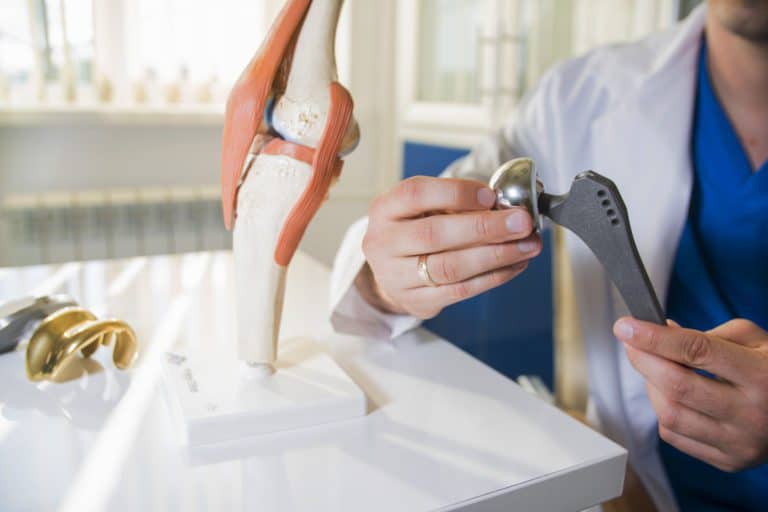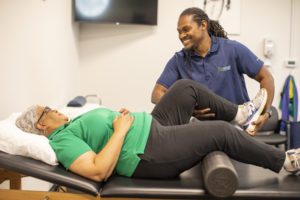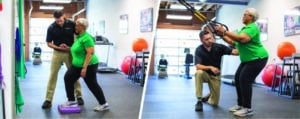
Total Joint Hip Replacement Surgery Recovery
Each year, there are more than 500,000 people who undergo a total hip replacement, arthroplasty. If you, or someone you know, are one of those people who suffer from hip pain and are seeking a solution, we are answering the most asked questions regarding total hip replacement surgery and hope you find the following information helpful as you research the hip replacement recovery process.
What is the recovery time for a hip replacement?
While there are physician-specific protocols for this common surgery, timelines for walking ‘normally’ with a new hip can vary significantly. A common challenge faced by physicians regarding patients’ post-joint replacement is often not the rehabilitation process of the joint, but how many months, and in most cases years, of pain have altered a patient’s mechanics pre-surgery.
A typical recovery process can look like this:
- Walking without a cane at 2-4 weeks
- Normalized walking pattern at 4-8 weeks
- Rebalancing of strength and mechanics up to 6 months
It is a universal principle of physical therapy that restoring normal, symmetrical walking patterns is a critical component of a successful hip replacement recovery.
How long will I be confined to bed rest after a hip replacement?
Contrary to popular belief, hip replacement patients are not placed on bed rest even for a short period of time post-surgery. Most orthopedic surgeons require that their patients are up and walking on their new hip hours out of surgery, once anesthesia has worn off. Patients remain in the hospital or surgical center until they can walk on their own, using an assistive device.
In-hospital physical therapy will teach you:
- How to get in and out of the bed
- Basic post-operative exercises
- How to walk with assistive devices
- Home exercises
- How to navigate the bathroom, stairs, and getting in and out of a car
The physical and occupational therapists’ goals are for you to return home safely in the shortest period of time.

What am I unable to do after a hip replacement?
The answer is, “it depends.” There are two common types of approaches for traditional hip replacement surgery – anterior and posterior. Anterior means the orthopedic surgeon approaches the hip surgery from the front and side and posterior approach means the hip is replaced from slightly behind and the side.
Factors surgeons consider before making the best choice for their patient:
- Activity level
- Size
- Age
Depending on what approach is chosen, post-operative restrictions will vary. Whenever tissues like muscle and tendons are impacted by surgery, it is important that these tissues are protected until they have healed and returned to maximum strength. Post-surgery, you will learn and practice how to move safely in the early stages of recovery. Because a total hip replacement is a common surgery with many years of research behind it, the pre-and post-surgical process, education, recovery programs, and support for patients have grown exponentially.
How long does the pain last after a hip replacement?
Again, the answer is, “it depends.” Swelling in and around the joint can make the first movements in the morning or after a prolonged rest difficult and stiff for 6-8 months post-surgery. It is important, however, to distinguish between stiffness and pain. Muscle pain and soreness can persist for up to 10 weeks following surgery.
Pain is commonly affected by:
- Movement and activity
- Nutrition
- Quality of sleep
- Anxiety and depression
- History of pain
A comprehensive approach to managing pain is best and opiates are rarely required following a hip replacement surgery after the first 48 hours. Positioning and movement prescription are usually the best medicine.
How do I know if I need hip replacement surgery?
Your body will tell you when it is time. A diagnosis of hip arthritis does not mean you must rush into a total hip replacement. Once your physician has made a diagnosis, there are several things you can do to delay the need for replacement:
- Movement (walking, riding a stationary bike, etc.)
- Increase hip mobility to naturally lubricate the joint
- Physical therapy exercises
If you have previously tried the listed recommendations, injections, or medications and are still limited by your hip, it may be time to consider surgery. If your hip is limiting your quality of life or partaking in the things you enjoy, it is likely time to speak with an orthopedic surgeon about the possibility of hip resurfacing or replacement.
See related: Shoulder Surgery Recovery: What to Know

How can physical therapy help?
Pre-habilitation
Long-term arthritic changes in your problem hip can impact your entire body through compensatory movements and changes in the way you walk and move. When a physical therapist evaluates your joint mobility, strength, balance, and gait (walking, and how you move), a plan can be developed to maximize the efficiency of your recovery as well as prepare you physically for what’s ahead. Research tells us that people who physically prepare for their hip surgery with prehab have shorter hospital stays, less pain, better sleep, and faster return to function.
Post-rehabilitation
Physical therapy after surgery will look to remedy not only the surgically repaired joint but will also look to restore strength and normal biomechanics in the other parts of the body which deteriorated during the years and months prior to surgery. Physical therapists will utilize techniques such as soft tissue mobilization or manual therapy to improve the mobility of these joints which will help normalize your walking.
Often it is asked, “Will physical therapy hurt?”
While any movement after surgery can be initially stiff and sore, once the arthritic pain is resolved through surgery, hip replacement patients often find that physical therapy exercises feel GOOD.
Movement is medicine.
Done correctly, purposefully, and with the skill you would expect from a physical therapist with many years of clinical experience and training, you should experience minimal discomfort. In addition to manual therapy, your physical therapist can recommend stretches and exercises that are selected for each individual to maximize their success.
Article By: Steven L. Coppolecchia PT, DPT, OCS
Steve began his physical therapy career 8 years ago and has worked in South Carolina, New York City, and numerous locations throughout New Jersey. Steve loves working with the orthopedic, sports, and vestibular populations of all ages and believes in the importance of providing quality and individually directed treatment to every patient with a special focus on manual therapy and education of each patient’s condition. He currently treats patients at Ivy Rehab Physical Therapy in River Vale, NJ, and can be reached via email at: steven.coppolecchia@ivyrehab.com.
The medical information contained herein is provided as an information resource only, and does not substitute professional medical advice or consultation with healthcare professionals. This information is not intended to be patient education, does not create any patient-provider relationship, and should not be used as a substitute for professional diagnosis, treatment or medical advice. Please consult with your healthcare provider before making any healthcare decisions or for guidance about a specific medical condition. If you think you have a medical emergency, call your doctor or 911 immediately. IvyRehab Network, Inc. disclaims any and all responsibility, and shall have no liability, for any damages, loss, injury or liability whatsoever suffered as a result of your reliance on the information contained herein.